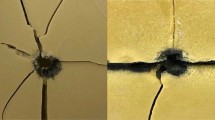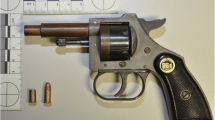Abstract
From time to time, severe or fatal injuries caused by small caliber air rifle projectiles are seen. In forensic sciences, the theoretical wounding potential of these weapons and projectiles is widely known. Usually, shots against the skull were reported and, in these cases, penetrating the eyes or thin bone layers of the temporal region. Amongst a huge number of different projectiles available for air guns, sub-caliber 4.4-mm (.173) caliber steel ball projectiles were used in an unusual suicide case. This case led to fundamental questions concerning wound ballistics. An 82-year-old man shot once against his right temporal region and twice into his mouth with a 4.5-mm (.177) caliber air rifle. Because of the exceptionally deep penetration of the base of the skull and the use of spherical-shaped sub-caliber air rifle projectiles, terminal ballistic features were analyzed and compared to results published in forensic literature. Test shots using the same weapon and similar projectiles were fired into ballistic gelatin to measure and calculate basic wound ballistic variables of cal. 4.4-mm (.173) steel balls. In comparison, further test shots with cal. 4.5-mm (.177) steel balls BB (ball bearing), flat-headed and pointed air rifle pellets (“diabolos”) were carried out. The theoretical penetration depth in solid bone was calculated with 36.4 mm, and test shots in gelatin from hard contact produced an on-average wound track of 120 mm underlining the potential wounding effect. Furthermore, spherical projectiles could roll back and forth within the barrel, and an air cushion between projectile and breechblock can reduce muzzle velocity by more than half, explaining the retained missile in the temporal region.




Similar content being viewed by others
References
Dittmann W (1986) Gehirnschussverletzungen durch Luftdruckwaffen. Z Rechtsmed 96:119–131
Fackler ML, Malinowski JA (1988) Ordnance gelatin for ballistic studies. Am J Forensic Med Path 9:218–219
Fackler ML (1992) Police handgun ammunition selection. Wound Ballistics Rev 1:32–37
Fischer H, Heinemann A (2016) Working Group for Forensic Imaging of the German Society of Legal Medicine. Fundamentals of postmortem computer tomography (PMCT) in Forensic Radiology—recommendations and applications. Rechtsmedizin 26:284–290. https://doi.org/10.1007/s00194-016-0096-z
Frank M, Schönekeß H, Herbst J, Staats HG, Ekkernkamp A, Nguyen TT, Bockholdt B (2014) Subcaliber discarding sabot air gun projectiles. Int J Legal Med 128:303–308
Goroncy C (1924) Handlungsfähigkeit Kopfschussverletzter. Dtsch Z Gerichtl Med 4:145–164
Grundfest H (1945). Penetration of steel spheres into bone. Nat. Research Counc, Missiles Cas. Rep. No. 10
Heide S, Lessig R, Richter C, John E (2013) Überlebte Schussverletzungen. Rechtsmedizin 22:396–398
Karger B (1995a) Penetrating gunshots to the head and lack of immediate incapacitation. I. Wound ballistics and mechanisms of incapacitation. Int J Legal Med 108:53–61
Karger B (1995b) Penetrating gunshots to the head and lack of immediate incapacitation. II. Review of case reports. Int J Legal Med 108:117–126
Karger B (1996) Differentiation of hunting accident and suicide with rifles. Versicherungsmedizin 48(1):11–15
Karger B, Brinkmann B (1997) Multiple gunshot suicides: potential of physical activity and medico-legal aspects. Int J Legal Med 110:188–192
Karger B, Billeb E, Koops E, Brinkmann B (2002) Autopsy features relevant for discrimination between suicidal and homicidal gunshot injuries. Int J Legal Med 116:273–278
Kamphausen T, Althaus L, Küpper U, Rothschild MA, Bajanowski T (2014) Tödliche Schussverletzung eines Motorradrockers. Weiteres potenzielles Opfer im Rockerkrieg? Rechtsmedizin 24:502–507
Kamphausen T, Peschel O, Rothschild MA, Janßen K, Banaschak S (2017) Rechtsmedizinische Untersuchungen bei Amokfällen. Rechtsmedizin 27:167–174. https://doi.org/10.1007/s00194-017-0158-x
Kettner M, Ramsthaler F, Grabherr S et al (2017) Forensische Bildgebung im deutschsprachigen Raum – eine Bestandsaufnahme. Rechtsmedizin 27:407–413. https://doi.org/10.1007/s00194-017-0157-y
Kneubuehl BP (2013). Geschosse Gesamtauflage – Ballistik, Messtechnik, Wirksamkeit, Treffsicherheit. Stocker-Schmid, Dietikon-Zürich
Kneubuehl BP, Coupland R, Rothschild MA, Thali M (2008) Wundballistik – Grundlagen und Anwendungen, 3. Auflage edn. Springer Verlag, Heidelberg
Missliwetz J (1983) Phänomenologie von Selbsttötungen mit mehrfachen Schussverletzungen. Arch Kriminol 171:143–150
Monticelli F, Seidl S, Betz P (2002) Air rifle injury with an entrance through the nose: a case report and review of the literature. Int J Legal Med 116:292–294
Newgard K (1992) The physiological effects of handgun bullets. Wound Ballistics Rev 1:12–17
Rothschild MA, Schneider V (2000) Gunshot wound to the head with full recovery. In J Legal Med 113:349–351
Schyma C, Brünig J, Madea B, Jackowski C (2016) Die Endoskopie des Waffenlaufs. Rechtsmedizin 26:224–229. https://doi.org/10.1007/s00194-016-0086-1
Schyma C, Brünig J, Jackowski C, Müller R (2017) Messung der Geschossgeschwindigkeit mittels Hochgeschwindigkeitskamera. Rechtsmedizin 27:273–277. https://doi.org/10.1007/s00194-017-0180-z
Sellier K, Knüpling H (1969) Über die Eindringtiefe von Geschossen in Knochen. Arch Kriminol 144:155–160
Sellier K (1982) Schusswaffen und Schusswirkung I. Ballistik-Medizin-Kriminalistik. Schmidt-Römhild, Lübeck
Sellier K (1988) Schussentfernungsbestimmung. Schmidt-Römhild, Lübeck
Walcher K (1929) Über Bewusstlosigkeit und Handlungsfähigkeit. Dtsch Z Gerichtl Med 13:313–322
Waffengesetz Deutschland [German weapons law] (2002) Waffengesetz vom 11. Oktober 2002 (BGBl. I S. 3970, 4592, 2003 I S. 1957), das durch Artikel 1 des Gesetzes vom 30. Juni 2017 (BGBl. I S. 2133) geändert worden ist. www.gesetze-im-internet.de/waffg_2002/BJNR397010002.html, visited: 15.11.2017
Werner R, Schultz B, Bockholdt B, Ekkernkamp A, Frank M (2017) Energy-dependent expansion of .177 caliber hollow-point air gun projectiles. Int J Legal Med 131:685–690
Wolff F, Lauffer M (1965) Tödliche Kopfschussverletzung durch Luftgewehr. Arch Kriminol 136:78–83
Acknowledgements
We thank Lesley-Anne Weiling from Write English GbR for the language editing.
Author information
Authors and Affiliations
Corresponding author
Ethics declarations
Conflict of interest
The authors declare that they have no conflict of interest.
Ethical approval
For this type of study, formal consent is not required. This article does not contain any studies with human participants or animals performed by any of the authors.
Rights and permissions
About this article
Cite this article
Kamphausen, T., Janßen, K., Banaschak, S. et al. Wounding potential of 4.4-mm (.173) caliber steel ball projectiles. Int J Legal Med 133, 143–150 (2019). https://doi.org/10.1007/s00414-018-1816-6
Received:
Accepted:
Published:
Issue Date:
DOI: https://doi.org/10.1007/s00414-018-1816-6




